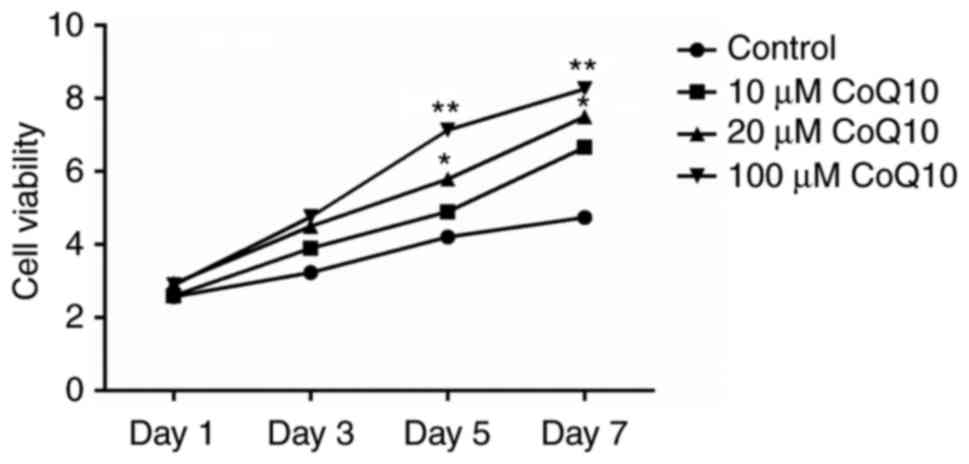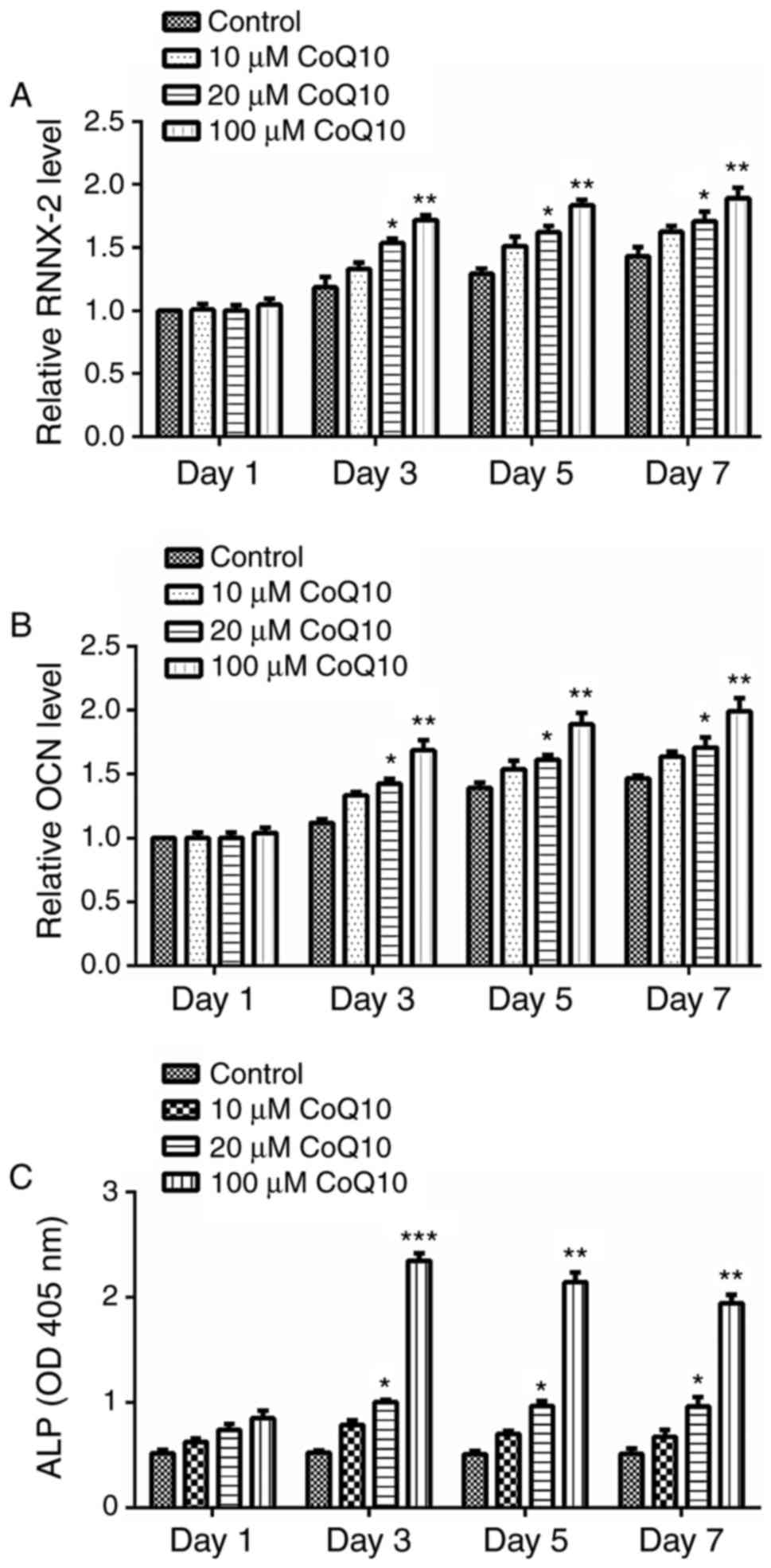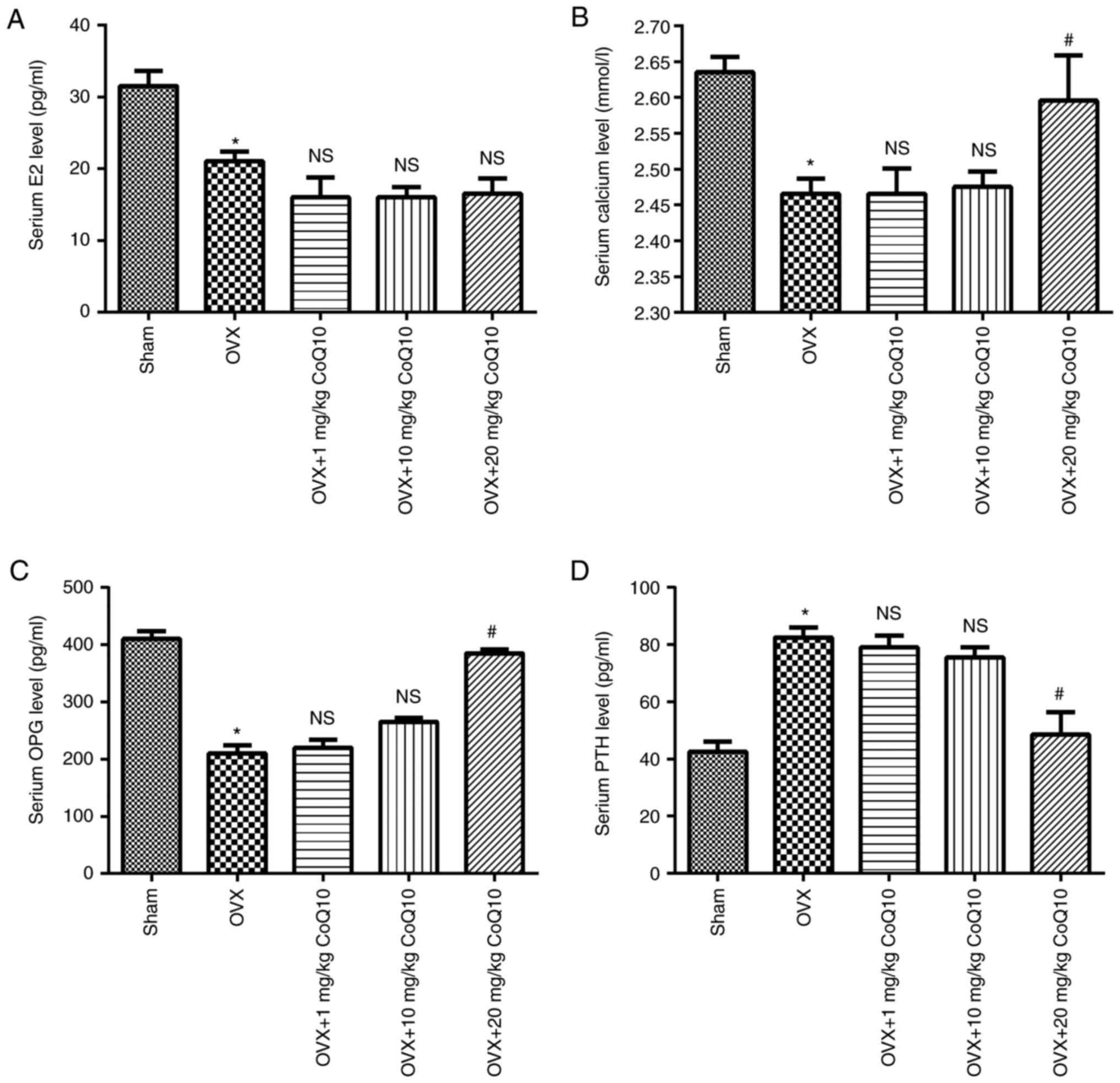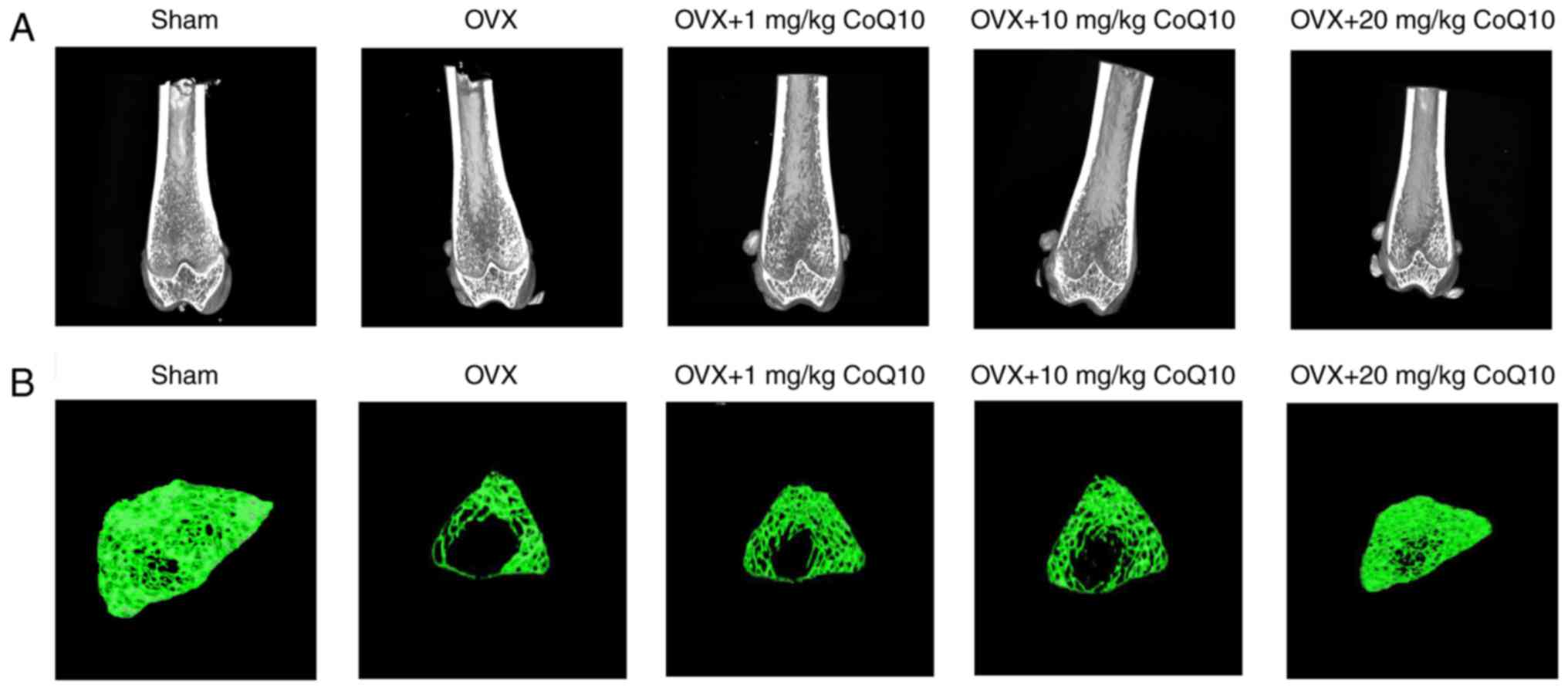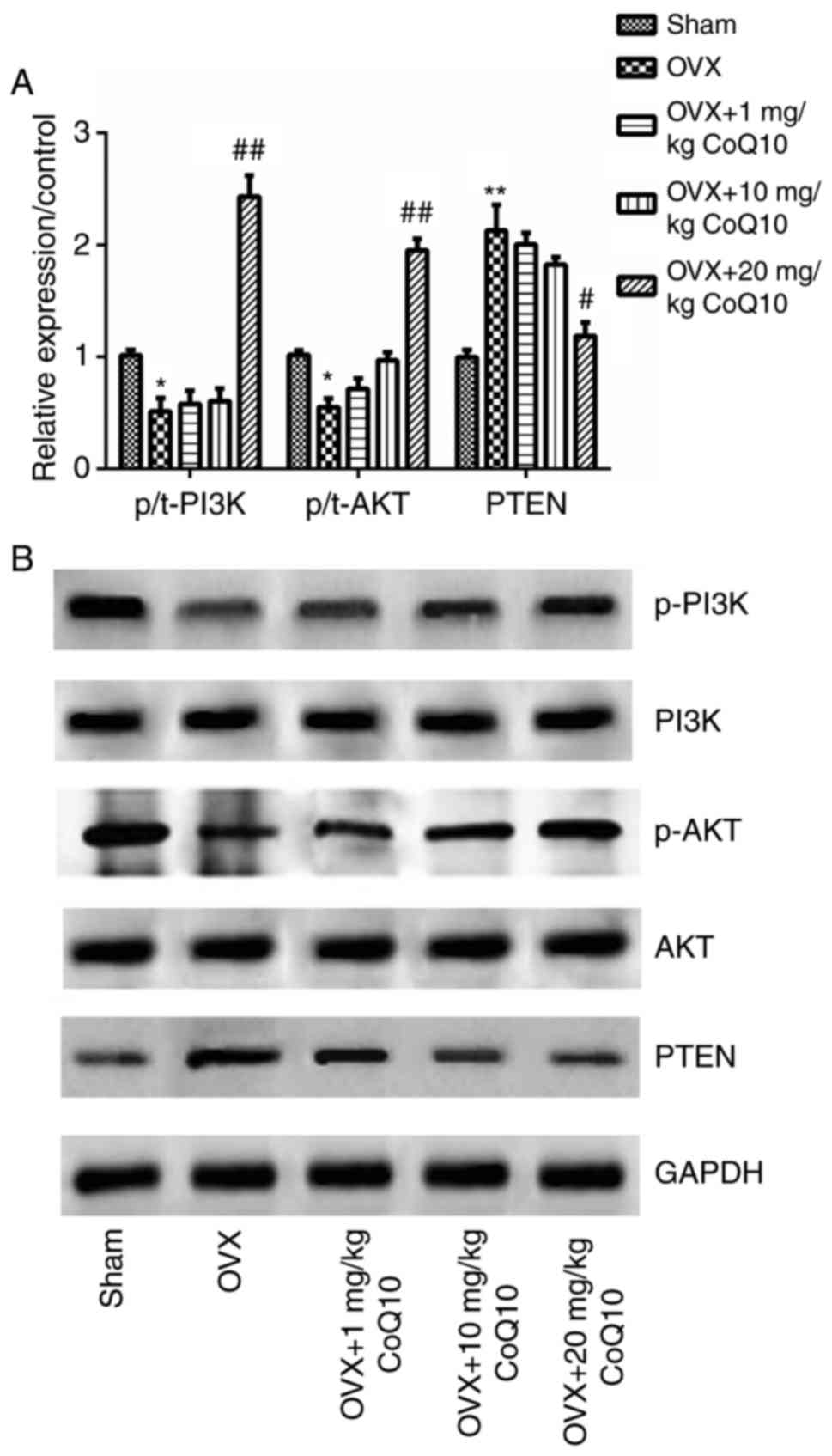Coenzyme Q10 promotes osteoblast proliferation and differentiation and protects against ovariectomy-induced osteoporosis
- Authors:
- Published online on: October 26, 2017 https://doi.org/10.3892/mmr.2017.7907
- Pages: 400-407
Abstract
Introduction
Osteoporosis is a systemic skeletal disease leading to fragility fractures and has become a major health problem in the world (1). Osteoporosis primarily affects women, and it has been reported that ~40% of postmenopausal women in the USA suffer from osteoporosis (2,3). With an ageing population, the medical and socioeconomic burden of osteoporosis is expected to gradually increase globally in the near future (4–6). Although mechanisms underlying the pathogenesis of osteoporosis remain to be elucidated, an number of studies suggested that the reduction of bone mineral density (BMD) and deterioration of bone microarchitecture are responsible for the development and progression of osteoporosis. Therefore, a novel treatment for osteoporosis should aim to prevent excessive bone resorption and to enhance bone formation (1).
Coenzyme Q10 (CoQ10), also known as ubiquinone, ubidecarenone or coenzyme Q, is a lipid-soluble vitamin-like substance. It serves a role in the electron transport chain involved in the generation and regulation of cellular bioenergy (7,8). CoQ10 demonstrates bioenergetic and antioxidant properties (9). Therefore, it is commonly used for the treatment of a variety of diseases, including heart, metabolic, nervous system and reproductive system diseases, and cancer (10). CoQ10 prevents the onset of bone disease and regulates osteoblast and osteoclast differentiation (11,12). However, little is known about the efficacy of CoQ10 for the treatment of osteoporosis.
Therefore, the aim of the present study was to investigate the effects of CoQ10 on osteoblastic cell proliferation and differentiation in vitro, and on therapeutic efficacy of the treatment of osteoporosis in a rat model of the disease in vivo, as well as the underlying mechanism. Proliferation and differentiation of rat bone marrow stromal cells (BMSCs), and levels of osteoblastogenic markers, were determined following treatment with different concentrations of CoQ10. Serum levels of bone metabolism markers were determined in ovariectomy (OVX)-induced rats with osteoporosis treated or untreated with CoQ10. Effects of CoQ10 on morphological bone changes and cellular signaling pathways were investigated. The present study provides novel insights into potential treatment strategies of osteoporosis.
Materials and methods
Animals and experimental design
Female Sprague-Dawley (SD) rats (8-months old, 250–350 g, n=48) were obtained from the Experimental Animal Center of Dalian Medical University (Dalian, China). All rats were acclimatized for at least one week prior to the experiments. Animals were housed individually in standard laboratory cages with controlled temperature and humidity (22–25°C; 50–65%) under a 12-h light/dark cycle. Rats had access to food and water ad libitum. A total of 8 rats were randomly selected and used in the in vitro experiment, and BMSCs were obtained from them. Remaining rats (n=40) were used to conduct in vivo experiments. All experiments were approved by the Ethics Committee on Animals at Dalian University (Dalian, China) and performed in accordance with the standards set by the Guide for the Care and Use of Laboratory Animals published by the National Institutes of Health (Bethesda, MD, USA).
Primary culture of BMSCs and treatment with CoQ10
BMSCs were isolated as previously described (13,14). SD rats were subjected to euthanasia by inhalation of 70% CO2 and femurs and tibias were harvested. Bone marrow was removed, filtered through a 70-µm nylon mesh and centrifuged at 1,200 × g for 8 min at 4°C. Collected cells were cultured in Dulbecco's modified Eagle's medium (DMEM) supplemented with 10% fetal bovine serum, 2 mM glutamine, 100 U/ml penicillin and 100 µg/ml streptomycin (all, Thermo Fisher Scientific, Inc., Waltham, MA, USA) at 37°C with 5% CO2 for 3 days. Subsequently, adherent cells were washed three times with PBS and cultured in DMEM until 90% confluence was attained. Following 3 or 4 passages, BMSCs were treated with vehicle (soya bean oil) or various concentrations of CoQ10 (10, 20 or 100 µM, Sigma-Aldrich; Thermo Fisher Scientific, Inc.). CoQ10 was dissolved in soya bean oil at 40°C.
Cell proliferation
Viability of BMSCs was assessed by using 3-(4,5-dimethylthiazol-2-yl)-2, 5-diphenyltetrazolium bromide (MTT) assay (Sigma-Aldrich; Merck KGaA, Darmstadt, Germany). Cells (2×104 cells/ml) were seeded in 96-well plates and treated with a vehicle or various concentrations of CoQ10 (10, 20 or 100 µM) for 24 h. On days 1, 3, 5 and 7 prior to the treatment, cells were incubated with an MTT solution (20 µl, 0.5 mg/ml) for 4 h at 37°C, followed by an addition of dimethylsulfoxide (Sigma-Aldrich; Merck KGaA). The absorbance was measured at a wavelength of 590 nm with a SpectraMax 340 microplate reader (Molecular Devices LLC, Sunnyvale, CA, USA).
Alkaline phosphatase (ALP) activity assay
The activity of ALP was determined as previously described (12). BMSCs (5×103 cells/ml) were seeded in 96-well plates and incubated with vehicle or 10, 20 or 100 µM CoQ10 for 24 h at room temperature. Following pre-treatment with vehicle or CoQ10, 20 µl p-nitrophenyl phosphate (pNPP; 1 mg/ml; Sigma-Aldrich; Merck KGaA) was added to the RIPA buffer solution for 30 min at 37°C on days 1, 3, 5, and 7 of the experiment, according to the manufacturer's protocol. Enzymatic activity was quantified by ALP ELISA kit (cat. no. 687242; Antibody Research Corp., St. Peters, MO, USA) and absorbance measured at a wavelength of 405 nm with a SpectraMax Plus384 reader (Molecular Devices LLC).
Reverse transcription quantitative polymerase chain reaction (RT-qPCR)
Expression of osteogenic markers, runt-associated transcription factor 2 (RUNX-2) and osteocalcin (OCN), was assessed by RT-qPCR. Total RNA was isolated from BMSCs using the RNeasy Mini kit (Qiagen Inc., Valencia, CA, USA) according to the manufacturer's protocol. First-strand complementary DNA was synthesized using Superscript III Reverse Transcriptase (Invitrogen; Thermo Fisher Scientific, Inc.). Reverse transcription was performed at 55°C for 60 min. Expression levels were determined using SYBR green-based qPCR (SYBR Green PCR Master Mix; Applied Biosystems; Thermo Fisher Scientific, Inc.). PCR was undertaken according to the following parameters: 1 predenaturation cycle of 1 min at 94°C, 40 cycles of 95°C for 30 sec, 60°C for 30 sec, and 72°C for 2 min, and a final extension at 72°C for 5 min. All primers were supplied by Genepharma Co., Ltd. (Shanghai, China) and are listed in Table I. Expression was normalized to GAPDH using the comparative 2−ΔΔCq method (15).
Western blot analysis
Total protein was extracted from BMSCs or rat femurs using radioimmunoprecipitation assay lysis buffer (Beyotime Institute of Biotechnology, Shanghai, China). Protein concentration was assessed using a Bicinchoninic Acid protein assay kit (Beyotime Institute of Biotechnology) according to the manufacturer's protocol. Proteins were separated by 10–12% SDS-PAGE and transferred to nitrocellulose membranes (EMD Millipore, Billerica, MA, USA) and blocked with 5% dried skimmed milk in Tris buffered saline with Tween-20. Membranes were then probed with: Anti phosphatidylinositol 4,5-bisphosphate 3-kinase (PI3K, 1:1,000, cat. no. mAb4249), phosphorylated (p)-PI3K (1:1,000, cat. no. 4228), RAC-alpha serine/threonine-protein kinase (AKT, 1:1,000, cat. no 4691), p-AKT (1:1,000, cat. no 4060, all Cell Signaling Technology, Inc., Danvers, MA, USA) or phosphatidylinositol 3,4,5-trisphosphate 3-phosphatase and dual-specificity protein phosphatase PTEN (PTEN; cat. no. ab32199; Abcam, Cambridge, USA) primary antibodies overnight at 4°C. Anti-GAPDH (1:2,000, cat. no. sc-25778) Santa Cruz Biotechnology, Inc., Dallas, TX, USA) was used as a loading control and was incubated overnight at 4°C. Following washing with PBS, membranes were incubated with a horseradish peroxidase-conjugated secondary antibody (1:5,000, cat. no. sc-2372, Santa Cruz Biotechnology, Inc.). Immunoreactive protein bands were visualized by enhanced chemiluminescence Western blotting substrate (Roche Applied Science, Penzberg, Germany).
In vivo experiment
The rats were randomly divided into 5 groups (n=8 per group): i) the sham group, where rats were subjected to a sham surgery that involved exposing but not removal of ovaries, and received normal feedstuff for 3 months; ii) the OVX group, where rats were subjected to OVX operation and received normal feedstuff for 3 months; iii) the OVX+1 mg/kg CoQ10 group, where rats were subjected to OVX and treated with 1 mg/kg CoQ10 by intraperitoneal injection every 5 days for 3 months; iv) the OVX+10 mg/kg CoQ10 group where, rats were subjected to OVX and treated with 10 mg/kg CoQ10 by intraperitoneal injection every 5 days for 3 months; and v) the OVX+20 mg/kg CoQ10 group, where rats were subjected to OVX and treated with 20 mg/kg CoQ10 by intraperitoneal injection every 5 days for 3 months.
OVX and sample collection
Rats were subjected to OVX as previously described (16). Animals were anesthetized by an intraperitoneal injection of 8% chloral hydrate solution (Sigma-Aldrich; Merck KGaA). Following anesthesia, rats were subjected to bilateral OVX by the dorsal approach. Six hours after the last dose of CoQ10, all animals were sacrificed. Blood samples (4 ml) were collected from hearts and stored at −20°C. Blood samples were then centrifuged at 1,200 × g for 10 min at room temperature. Whole femurs were dissected and fixed in 4% paraformaldehyde for a subsequent micro-computed tomography (CT) analysis.
Biochemical analysis of serum
Levels of serum estrogen (E2) (cat. no. IB79329, IBL-America Inc., Spring Lake, MN, USA) and serum bone metabolism markers, including calcium, parathyroid hormone (PTH) (cat. no. 60–2500, Immutopics Inc., San Clemente, CA, USA) and osteoprotegerin (OPG) (cat. no. BE69058; IBL-America Inc.), were measured by ELISA. Serum calcium levels were determined using an Accucare Calcium Arsenazo III kit (Serotec Co., Ltd., Hokkaido, Japan).
Micro-CT analysis of femur bones
High-resolution micro CT scans (SCANCO viva; version 4.0; Scanco Medical AG, Brüttisellen, Switzerland) were performed on the sham- and CoQ10-treated joints. Changes in BMD and bone volume/total volume (BV/TV) ratio were evaluated using the Image-Pro software (version 7.0; Media Cybernetics Inc., Rockville, MD, USA) and SCANCO microCT software packages (version 6.0). The average trabecular number (Tb.N), average trabecular thickness (Tb.Th) and average trabecular separation (Tb.Sp) were assessed by the plate model 16 set-up: Tb.N=0.5 bone surface (BS)/TV; Tb.Th=2 BV/BS; Tb.Sp=2 (TV-BV)/BS (17).
Statistical analysis
All experiments were repeated at least three times. The data are expressed as the mean ± standard error. Student's t-test was used to determine differences between the two groups, and one-way analysis of variance was performed to compare differences among three groups, followed by the Student-Newman-Keuls post-hoc test. P<0.05 was considered to indicate statistically significant differences. Results were analyzed using SPSS software (version 18.0; SPSS, Chicago, IL, USA).
Results
Effect of CoQ10 on the viability of BMSCs
The viability of BMSCs was analyzed by MTT following 1, 3, 5 and 7 days of treatment with various concentrations of CoQ10 (10, 20 or 100 µM). As presented in Fig. 1, 10 µM CoQ10 increased cell viability but the difference was not statistically significant. Cell viability was not significantly altered on days 1 and 3 at any dose. CoQ10 administrated at a dose of 20 or 100 µM exhibited significant stimulatory effects on cell viability on days 5 and 7 (P<0.05 or P<0.01) in a dose-dependent pattern. The data suggests that CoQ10 promotes viability of BMSCs.
Effect of CoQ10 on the expression of osteogenic markers in BMSCs
RUNX-2, OCN and ALP are osteogenic markers. Following treatment with different concentrations of CoQ10 (10, 20 or 100 µM), the expression levels of RUNX-2, OCN and ALP in BMSCs on days 1, 3, 5, and 7 were measured by RT-qPCR and ELISA. As indicated in Fig. 2, the expression of RUNX-2, OCN and ALP was significantly increased by the treatment with 20 or 100 µM CoQ10 on days 3, 5, and 7 (P<0.05, P<0.01, or P<0.001), in a dose-dependent manner. No significant differences were observed on day 1 and following treatment with 10 µM CoQ10 on any day. The results suggest that 20 and 100 µM CoQ10 can promote osteogenic differentiation of BMSCs.
Effect of CoQ10 on serum E2 levels and serum bone metabolism markers
To investigate the effects of CoQ10 on osteoporosis, a rat model of osteoporosis was established by OVX followed by the administration of CoQ10. Serum levels of E2 and bone metabolism markers (calcium, OPG and PTH) were determined following administrating different concentrations of CoQ10. As presented in Fig. 3, the levels of E2, calcium and OPG was significantly decreased in the OVX group compared with the sham group (all P<0.05), while PTH was significantly increased in the OVX group, compared with the sham group (P<0.05). Administration of 20 mg/kg CoQ10 significantly increased the levels of calcium and OPG and decreased the levels of PTH (all P<0.05) but exhibited no significant effect on the levels of E2 compared with the OVX group. Furthermore, no significant differences were observed in the abundance of E2, calcium, OPG and PTH between the OVX group and OXY+1 or 10 mg/kg treatment groups. The results demonstrated that 20 mg/kg CoQ10 can increase serum calcium and OPG and decrease PTH levels, which may be beneficial for patients with osteoporosis.
Effect of CoQ10 on bone morphology parameters
Micro-CT analysis was performed to evaluate bone morphology parameters. The results are presented in Table II. BMD, BV/TV, Tb.N. and Tb.Th. were significantly decreased in the OVX group compared with the sham group, while Tb.Sp. significantly increased (all P<0.001). Administration of CoQ10 (1, 10, or 20 mg/kg) significantly increased BMD and Tb.N. and reduced Tb.Sp, compared with the OVX group (all P<0.001). Only administration of 20 mg/kg CoQ10 exhibited significant stimulatory effects on BV/TV and Tb.Th, compared with the OVX group (all P<0.001). Fig. 4A presents micrographs of the vertical section of distal femur in different groups. The analysis revealed poor trabecular structure in the OVX group compared with the sham group. CoQ10 treatment improved the trabecular microstructure (Fig. 4A) and trabecular thickness (Fig. 4B) in a dose-dependent manner compared with OVX group. The results demonstrated that CoQ10 may protect against osteoporosis by improving bone formation.
Effect of CoQ10 on the PTEN/PI3K/AKT pathway
It has been previously demonstrated that activation of the PI3K/AKT pathway protects against osteoporosis and controls multiple cell processes, including cell proliferation, differentiation and cell apoptosis. PTEN is a known negative regulator of PI3K/AKT. Therefore, mRNA and protein expression levels of PTEN/PI3K/AKT key factors, were analyzed. The results revealed that OVX significantly decreased the levels of phosphorylated to total ratio (p/t)-PI3K and p/t-AKT but significantly increased the levels of PTEN compared with the sham group (P<0.05 or P<0.01). There were no significant differences in the levels of p/t-PI3K, p/t-AKT and PTEN following administration of 1 or 10 mg/kg CoQ10 compared with the OVX group. However, significant differences were observed in the relative protein expression of p/t-PI3K, p/t-AKT and PTEN following administration of 20 mg/kg CoQ10, compared with the OVX group (P<0.05 or P<0.01; Fig. 5A and B). The above results indicate that CoQ10 activates the PTEN/PI3K/AKT signaling pathway.
Discussion
In the present study, potential therapeutic effects of CoQ10 on osteoporosis were investigated in vivo and in vitro. The results revealed that CoQ10 significantly increased the proliferation and osteogenic differentiation of BMSCs in a dose-dependent manner. In addition, Therefore, CoQ10 significantly decreased bone resorption and enhanced bone formation. Furthermore, the results demonstrated that CoQ10 activated the PTEN/PI3K/AKT signaling pathway. CoQ10 presents protective effects on osteoporosis and may be a potential candidate for the treatment of osteoporosis.
In previous studies, several different types of drugs have been proposed for bone treatment, including bisphosphonates, estrogen and raloxifene (18–21). However, in spite of their effectiveness, certain drugs present side effects, including thromboembolism and oesophageal irritation (1,22–24). Therefore, novel drugs that aim to improve bone therapy are required. CoQ10 demonstrates membrane stabilizing activity and is an antioxidant with free radical scavenging activity and cell-protective effects. Effects of CoQ10 on human diseases have been widely studied, revealing the protective role of CoQ10 in heart failure, cancer, muscular dystrophy and periodontal disease (10,25–27). A previous study (11) demonstrated that CoQ10 acts as an inhibitor of osteoclastogenesis by downregulating the production of reactive oxygen species (ROS), and suggested that CoQ10 presents potential therapeutic implications in the treatment of osteoporosis and other bone diseases. However, both reports only focused on cell experiments, and the mechanism underlying effects of CoQ10 were not completely elucidated.
In the present study, experiments were performed on cell culture and rat models of osteoporosis. For the in vitro study, BMSCs were extracted from experimental rats. BMSCs are multipotent progenitor cells demonstrating a capacity to differentiate into multiple lineages, incluging osteoblasts, chondrocytes, adipocytes and myoblasts (28–30). The results of the present study confirmed that CoQ10 enhances the proliferation of BMSCs and promotes the osteogenic differentiation in a dose-dependent manner; these observations are similar to the results of a previous study (12). The above results were further verified by the observation that CoQ10 can promote the expression of osteoblastogenic markers, including RUNX-2, OCN and ALP, suggesting induction of a correct function of differentiated osteoblast cells (31). Treatment with 20 and 100 µM CoQ10 exhibited the highest impact on the differentiation of BMSCs. The levels of RUNX-2, OCN and ALP increased significantly 7 days following treatment, suggesting that the effects of CoQ10 are dose-dependent.
A previous study investigated the absorption, metabolism and pharmacokinetics of CoQ10 (32). Absorption of CoQ10 is slow and limited due to its hydrophobic properties and large molecular weight. It has been demonstrated that solubilized CoQ10 formulations exhibit increased bioavailability (32). Therefore, there is an association between the plasma CoQ10 levels and the dose of CoQ10 ingested at a given time point. To verify whether CoQ10 acts in a dose-dependent manner, therapeutic effects of CoQ10 on the OVX-induced model of osteoporosis were assessed using different doses (1, 10 and 20 mg/kg) of CoQ10. Following three months of treatment, serum levels of E2 and bone metabolism markers including calcium, OPG and PTH, were verified. CoQ10 supplementation exhibited no significant impact on the levels of E2, indicating that the effects of CoQ10 on osteoporosis are likely to be independent of E2. Significant changes in the levels of calcium, OPG and PTH were induced by 20 mg/kg CoQ10. Low serum calcium is an indicator of osteoporosis for postmenopausal women and OPG, a tumor necrosis factor receptor family member, is a key regulator of bone resorption (33). PTH is regarded a modulator of the development of osteoporosis, and excess PTH leads to osteoporosis (34). The results of the present study indicated that CoQ10 protects against osteoporosis and may regulate bone metabolism. Furthermore, the results of the present study demonstrated that CoQ10 supplementation effectively reversed osteoporotic changes and maintained bone structure by increasing BMD, BV, Tb.N and Tb.Th, and decreasing Tb.Sp. These results indicate a potential for safe therapeutic use of CoQ10 in the treatment of human diseases.
It has been previously demonstrated that PTEN/PI3K/AKT is a signaling pathway regulating several biological processes, including cell proliferation and metabolism (35). PTEN is a dual lipid and protein phosphatase, which mainly targets lipid phosphatidylinositol-3, 4,5-triphosphate and negatively regulates activation of PI3K and AKT (35,36). In vivo and in vitro studies suggested that the PI3K/AKT signaling pathway is responsible for the inhibition of osteoporosis by enhancing osteoblast proliferation and differentiation, and bone formation (37–39). Therefore, the present study hypothesized that the effects of CoQ10 on OVX-induced osteoporosis may be involved in the regulation of the PTEN/PI3K/AKT signaling pathway. The results of the present study demonstrated that OVX significantly increased the expression of PTEN but decreased the expression of p-PI3K and p-AKT, indicating that OVX inactivated the PI3K/AKT pathway. CoQ10 supplementation reserved these results, and the expression levels of p-PI3K and p-AKT were significantly increased in a dose-dependent manner. The present study obtained similar results to a previous study that revealed that CoQ10 can protect against amyloid beta-induced neuronal cell death by activating the P13K pathway (40).
In conclusion, the present study demonstrated that CoQ10 supplementation promotes proliferation and differentiation of BMSCs, and effectively suppresses OVX-induced bone loss by reversing osteoporotic changes and maintaining bone structure. These effects may be mediated by activation of the PTEN/PI3K/AKT signaling pathway. However, further clinical studies should be performed to verify these results.
References
|
Rachner TD, Khosla S and Hofbauer LC: Osteoporosis: Now and the future. Lancet. 377:1276–1287. 2011. View Article : Google Scholar : PubMed/NCBI | |
|
Burge R, Dawson-Hughes B, Solomon DH, Wong JB, King A and Tosteson A: Incidence and economic burden of osteoporosis-related fractures in the United States, 2005–2025. J Bone Miner Res. 22:465–475. 2007. View Article : Google Scholar : PubMed/NCBI | |
|
Ray NF, Chan JK, Thamer M and Melton LJ III: Medical expenditures for the treatment of osteoporotic fractures in the United States in 1995: Report from the National Osteoporosis Foundation. J Bone Miner Res. 12:24–35. 1997. View Article : Google Scholar : PubMed/NCBI | |
|
Qu B, Ma Y, Yan M, Wu HH, Fan L, Liao DF, Pan XM and Hong Z: The economic burden of fracture patients with osteoporosis in western China. Osteoporos Int. 25:1853–1860. 2014. View Article : Google Scholar : PubMed/NCBI | |
|
Hernlund E, Svedbom A, Ivergård M, Compston J, Cooper C, Stenmark J, McCloskey EV, Jönsson B and Kanis JA: Osteoporosis in the European Union: Medical management, epidemiology and economic burden. A report prepared in collaboration with the International Osteoporosis Foundation (IOF) and the European Federation of Pharmaceutical Industry Associations (EFPIA). Arch Osteoporos. 8:1362013. View Article : Google Scholar : PubMed/NCBI | |
|
Becker DJ, Kilgore ML and Morrisey MA: The societal burden of osteoporosis. Curr Rheumatol Rep. 12:186–191. 2010. View Article : Google Scholar : PubMed/NCBI | |
|
Groneberg DA, Kindermann B, Althammer M, Klapper M, Vormann J, Littarru GP and Döring F: Coenzyme Q10 affects expression of genes involved in cell signalling, metabolism and transport in human CaCo-2 cells. Int J Biochem Cell Biol. 37:1208–1218. 2005. View Article : Google Scholar : PubMed/NCBI | |
|
Linnane AW, Kios M and Vitetta L: Coenzyme Q(10)-its role as a prooxidant in the formation of superoxide anion/hydrogen peroxide and the regulation of the metabolome. Mitochondrion. 7 Suppl:S51–S61. 2007. View Article : Google Scholar : PubMed/NCBI | |
|
Littarru GP and Tiano L: Bioenergetic and antioxidant properties of coenzyme Q10: Recent developments. Mol Biotechnol. 37:31–37. 2007. View Article : Google Scholar : PubMed/NCBI | |
|
Jolliet P, Simon N, Barré J, Pons JY, Boukef M, Paniel BJ and Tillement JP: Plasma coenzyme Q10 concentrations in breast cancer: Prognosis and therapeutic consequences. Int J Clin Pharmacol Ther. 36:506–509. 1998.PubMed/NCBI | |
|
Moon HJ, Ko WK, Han SW, Kim DS, Hwang YS, Park HK and Kwon IK: Antioxidants, like coenzyme Q10, selenite, and curcumin, inhibited osteoclast differentiation by suppressing reactive oxygen species generation. Biochem Biophys Res Commun. 418:247–253. 2012. View Article : Google Scholar : PubMed/NCBI | |
|
Moon HJ, Ko WK, Jung MS, Kim JH, Lee WJ, Park KS, Heo JK, Bang JB and Kwon IK: Coenzyme q10 regulates osteoclast and osteoblast differentiation. J Food Sci. 78:H785–H891. 2013. View Article : Google Scholar : PubMed/NCBI | |
|
Panepucci RA, Siufi JL, Silva WA Jr, Proto-Siquiera R, Neder L, Orellana M, Rocha V, Covas DT and Zago MA: Comparison of gene expression of umbilical cord vein and bone marrow-derived mesenchymal stem cells. Stem Cells. 22:1263–1278. 2004. View Article : Google Scholar : PubMed/NCBI | |
|
Yu H, VandeVord PJ, Mao L, Matthew HW, Wooley PH and Yang SY: Improved tissue-engineered bone regeneration by endothelial cell mediated vascularization. Biomaterials. 30:508–517. 2009. View Article : Google Scholar : PubMed/NCBI | |
|
Livak KJ and Schmittgen TD: Analysis of relative gene expression data using real-time quantitative PCR and the 2(-Delta Delta C(T)) method. Methods. 25:402–408. 2001. View Article : Google Scholar : PubMed/NCBI | |
|
Ke B, Xu Z, Ling Y, Qiu W, Xu Y, Higa T and Aruoma OI: Modulation of experimental osteoporosis in rats by the antioxidant beverage effective microorganism-X (EM-X). Biomed Pharmacother. 63:114–119. 2009. View Article : Google Scholar : PubMed/NCBI | |
|
Laib A and Rüegsegger P: Calibration of trabecular bone structure measurements of in vivo three-dimensional peripheral quantitative computed tomography with 28-microm-resolution microcomputed tomography. Bone. 24:35–39. 1999. View Article : Google Scholar : PubMed/NCBI | |
|
Eriksen EF, Díez-Pérez A and Boonen S: Update on long-term treatment with bisphosphonates for postmenopausal osteoporosis: A systematic review. Bone. 58:126–135. 2014. View Article : Google Scholar : PubMed/NCBI | |
|
Fan JZ, Yang L, Meng GL, Lin YS, Wei BY, Fan J, Hu HM, Liu YW, Chen S, Zhang JK, et al: Estrogen improves the proliferation and differentiation of hBMSCs derived from postmenopausal osteoporosis through notch signaling pathway. Mol Cell Biochem. 392:85–93. 2014. View Article : Google Scholar : PubMed/NCBI | |
|
Lewiecki EM, Miller PD, Harris ST, Bauer DC, Davison KS, Dian L, Hanly DA, McClung MR, Yuen CK and Kendler DL: Understanding and communicating the benefits and risks of denosumab, raloxifene, and teriparatide for the treatment of osteoporosis. J Clin Densitom. 17:490–495. 2014. View Article : Google Scholar : PubMed/NCBI | |
|
Ramalho-Ferreira G, Faverani L, Prado F, Garcia I and Okamoto R: Raloxifene enhances peri-implant bone healing in osteoporotic rats. Int J Oral Maxillofac Surg. 44:798–805. 2015. View Article : Google Scholar : PubMed/NCBI | |
|
Lloyd M: Treatment of postmenopausal osteoporosis. N Engl J Med. 339:2021998. View Article : Google Scholar : PubMed/NCBI | |
|
Rodan GA and Martin TJ: Therapeutic approaches to bone diseases. Science. 289:1508–1514. 2000. View Article : Google Scholar : PubMed/NCBI | |
|
Kendler D: Osteoporosis: Therapies now and in the future. Climacteric. 14:604–605. 2011.PubMed/NCBI | |
|
Caso G, Kelly P, McNurlan MA and Lawson WE: Effect of coenzyme q10 on myopathic symptoms in patients treated with statins. Am J Cardiol. 99:1409–1412. 2007. View Article : Google Scholar : PubMed/NCBI | |
|
Lister RE: Coenzyme Q10 and periodontal disease. Br Dent J. 179:200–201. 1995. View Article : Google Scholar : PubMed/NCBI | |
|
Morisco C, Trimarco B and Condorelli M: Effect of coenzyme Q10 therapy in patients with congestive heart failure: A long-term multicenter randomized study. Clin Investig. 71 8 Suppl:S134–S136. 1993. View Article : Google Scholar : PubMed/NCBI | |
|
Pittenger MF, Mackay AM, Beck SC, Jaiswal RK, Douglas R, Mosca JD, Moorman MA, Simonetti DW, Craig S and Marshak DR: Multilineage potential of adult human mesenchymal stem cells. Science. 284:143–147. 1999. View Article : Google Scholar : PubMed/NCBI | |
|
Tuli R, Tuli S, Nandi S, Wang ML, Alexander PG, Haleem-Smith H, Hozack WJ, Manner PA, Danielson KG and Tuan RS: Characterization of multipotential mesenchymal progenitor cells derived from human trabecular bone. Stem Cells. 21:681–693. 2003. View Article : Google Scholar : PubMed/NCBI | |
|
Le Blanc K and Pittenger M: Mesenchymal stem cells: Progress toward promise. Cytotherapy. 7:36–45. 2005. View Article : Google Scholar : PubMed/NCBI | |
|
Neve A, Corrado A and Cantatore FP: Osteoblast physiology in normal and pathological conditions. Cell Tissue Res. 343:289–302. 2011. View Article : Google Scholar : PubMed/NCBI | |
|
Bhagavan HN and Chopra RK: Coenzyme Q10: Absorption, tissue uptake, metabolism and pharmacokinetics. Free Radic Res. 40:445–453. 2006. View Article : Google Scholar : PubMed/NCBI | |
|
Bekker PJ, Holloway D, Nakanishi A, Arrighi M, Leese PT and Dunstan CR: The effect of a single dose of osteoprotegerin in postmenopausal women. J Bone Miner Res. 16:348–360. 2001. View Article : Google Scholar : PubMed/NCBI | |
|
Orimo H, Fujita T and Yoshikawa M: Increased sensitivity of bone to parathyroid hormone in ovariectomized rats. Endocrinology. 90:760–763. 1972. View Article : Google Scholar : PubMed/NCBI | |
|
Carnero A, Blanco-Aparicio C, Renner O, Link W and Leal JF: The PTEN/PI3K/AKT signalling pathway in cancer, therapeutic implications. Curr Cancer Drug Targets. 8:187–198. 2008. View Article : Google Scholar : PubMed/NCBI | |
|
Maehama T and Dixon JE: The tumor suppressor, PTEN/MMAC1, dephosphorylates the lipid second messenger, phosphatidylinositol 3,4,5-trisphosphate. J Biol Chem. 273:13375–13378. 1998. View Article : Google Scholar : PubMed/NCBI | |
|
Xi JC, Zang HY, Guo LX, Xue HB, Liu XD, Bai YB and Ma YZ: The PI3K/AKT cell signaling pathway is involved in regulation of osteoporosis. J Recept Signal Transduct Res. 35:640–645. 2015. View Article : Google Scholar : PubMed/NCBI | |
|
Zhang Y, Zeng X, Zhang L and Zheng X: Stimulatory effect of puerarin on bone formation through activation of PI3K/Akt pathway in rat calvaria osteoblasts. Planta Med. 73:341–347. 2007. View Article : Google Scholar : PubMed/NCBI | |
|
Choi SC, Kim SJ, Choi JH, Park CY, Shim WJ and Lim DS: Fibroblast growth factor-2 and −4 promote the proliferation of bone marrow mesenchymal stem cells by the activation of the PI3K-Akt and ERK1/2 signaling pathways. Stem Cells Dev. 17:725–736. 2008. View Article : Google Scholar : PubMed/NCBI | |
|
Choi H, Park HH, Koh SH, Choi NY, Yu HJ, Park J, Lee YJ and Lee KY: Coenzyme Q10 protects against amyloid beta-induced neuronal cell death by inhibiting oxidative stress and activating the P13K pathway. Neurotoxicology. 33:85–90. 2012. View Article : Google Scholar : PubMed/NCBI |



